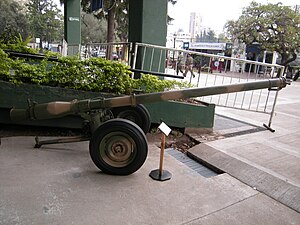The Model 1968 recoilless gun is a 105-mm antitank weapon developed and employed by Argentina. The weapon has been in active service since 1968 and 150 were still operational with Argentine forces as of 2000.[2] A similar weapon is the Argentine 105-mm Model 1974 FMK-1 recoilless gun.
| Modelo 1968 | |
|---|---|
 | |
| Type | Recoilless rifle |
| Place of origin | Argentina |
| Service history | |
| Used by | Argentina |
| Wars | Falklands War |
| Production history | |
| Designed | 1960s |
| Manufacturer | Rio Tercero Military Factory |
| Produced | 1968 |
| Specifications | |
| Mass | 397 kg (875 lb) |
| Length | 4.20 m (13.8 ft) |
| Barrel length | 3.00 m (9.84 ft) |
| Height | 1.07 m (3.5 ft) (Model 1974) |
| Crew | 4 |
| Shell | HEAT, HE |
| Elevation | -7 to +40°[1] |
| Traverse | 360° |
| Rate of fire | 3-5 rpm |
| Muzzle velocity | 400 m/s |
| Maximum firing range | 9,200 m (5.7 mi) |
| Sights | 4x optical stadiametric rangefinder |
Description
editThe Model 1968 is mounted on a towing carriage with wheels for transport and can be fired either with its wheels on or dismounted onto a tripod. Aiming is primarily done with the optical sight, but the weapon also includes a FAP (fusil automatico pesado, heavy automatic rifle) spotting rifle.[3] Ammunition for the Model 1968 includes both an 11-kilogram high-explosive and a 15-kilogram high-explosive anti-tank (HEAT) round. The Model 1974 fires a 16.6-kilogram HE round with a muzzle velocity of 400 meters/second and a 14.7-kilogram HEAT round at 514 meters/second.
The maximum range of the piece is 9,200 meters. Direct fire is limited to 1,800 meters using the optical sight with stadiametric rangefinder or 1,200 meters using the spotting rifle. The Model 1974's range characteristics are the same. The Model 1968 is credited with a 200 mm penetration of armor with its HEAT round.[4] The HEAT round for the Model 1974 can penetrate 400 mm of armor.[5]
Like many recoilless weapons, there is a significant back-blast from the Model 1968 with a 40-meter danger zone to the rear of the weapon.
Combat history
editIn the late 1960s or early 1970s, the Argentine military attempted to use it as a self-propelled gun or tank destroyer. At least two prototypes (one being either an IHC M5 or M9 half-track and the other a Bren carrier) were fitted with a six-cannon mount each, similar to that of the US-made M50 Ontos. Between 1977 and 1978, on the eve of Operation Soberanía, many carriers and half-tracks were converted to self-propelled guns by having a single Model 1968 mounted on them.[citation needed]
The Model 1968 was fielded by the Argentine Army during the Falklands War.[6] The Model 1974 is in service with Argentina and Guatemala.[citation needed]
Operators
editCurrent
editFormer
editReferences
edit- ^ ATW, p. 13
- ^ JWA, p. 25
- ^ JIW, p. 689.
- ^ For the caliber of the weapon and the era it was designed in, this estimate is probably less than the true performance of the weapon. Comparable weapons of the same era and caliber could penetrate 300 to 400mm of armor.
- ^ JIW 2008.
- ^ Montes, Julio A. (2 January 2015). "Infantry Support and Anti-tank Weapons in Latin America: 90mm and 105mm Recoilless Rifles". Small Arms Defense Journal. Vol. 6, no. 4.
- ^ "Armamento argentino olvidado por la historia en Centro América". Desarrollo y Defensa (in Spanish). 30 June 2015.
- ^ Decreto S 478/1981 (in Spanish). Boletín Oficial de la República Argentina. 19 June 1981. Retrieved 10 June 2018.
- ^ Decreto S 1742/1971 (in Spanish). Boletín Oficial de la República Argentina. 9 June 1971.
- ^ Ley N. 22.680 (in Spanish). Boletín Oficial de la República Argentina. 26 July 1983.
Bibliography
edit- (JIW) Hogg, Ian. Jane's Infantry Weapons 1984-85, London: Jane's Publishing Company Ltd., 1984.
- (JIW 2008) Jones, Richard, and Ness, Leland. Jane's Infantry Weapons 2007-2008, Coulsdon: Jane's Information Group Ltd., 2007.
- (JWA) Keymer, Eleanor. Jane's World Armies Issue Twenty-three, Coulsdon: Jane's Information Group Ltd., 2000.
- (ATW) Norris, John. Anti-tank Weapons, London: Brassey's, 1996.